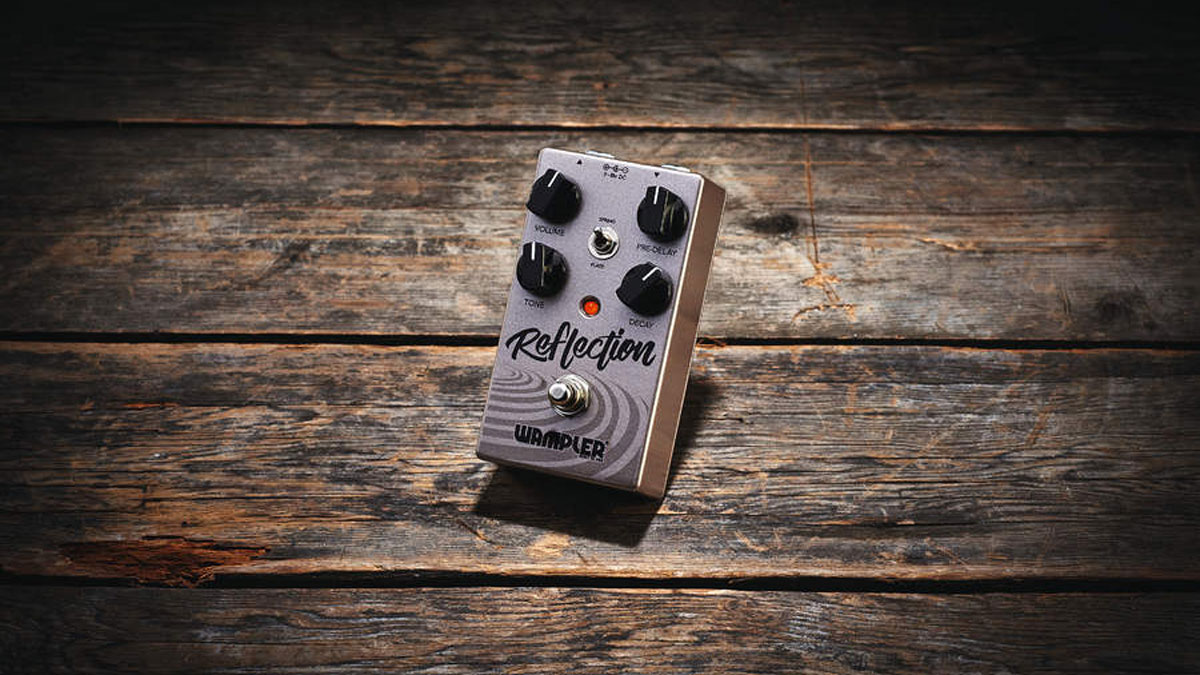MusicRadar Verdict
This easy-to-use pedal offers authentic-sounding spring sounds, making it a useful complement to an amp that doesn’t come equipped with a spring tank.
Pros
- +
Good emulation of spring and plate sounds.
- +
Easy to use, ’board-friendly, infinite reverb capability.
Cons
- -
Two types of reverb won’t be enough for all.
MusicRadar's got your back
Wampler decided the currently fashionable do-everything reverb pedals are too big and too complicated.
So the premise with this design is a pedal that offers the same washes of tone, while compact with simple controls and a single footswitch. Here, then, is the Reflection: certainly pedalboard friendly with its compact footprint and top-mounted jacks and also easy to use with just two reverb types and four knobs to set them up.
The only ‘complication’ here is that there’s no complication, with just two internal ‘set and forget’ DIP switches: one (Trails) that lets the decay die naturally when you hit bypass rather than be cut dead; and another to kill the dry sound, setting the pedal to 100 per cent wet so you could use it in an amp’s FX Loop.
If you want your shimmer and your modulated reverbs this probably won’t suit you as the pedal focuses solely on emulations of the two electro-mechanical reverb types that traditionally sit well with guitar: Spring and Plate reverbs that you’d get with a spring-tank equipped amp or have applied to guitar in a studio recording.
If you turn the Decay knob up full, the reverb will go on and on, so you can create those textural washes of ’verb that hang in the air behind your sound
There is, though, one feature that you’d find on those larger pedals: infinite reverb. If you turn the Decay knob up full, the reverb will go on and on, so you can create those textural washes of ’verb that hang in the air behind your sound. Both types of reverb sound excellent here, whether applied subtly or laid on thick, and there’s plenty of variation available.
Besides the decay time adjustment and wet/dry mix you get a pre-delay of up to 140ms before the main body of the reverb kicks in to help simulate different-sized spaces or put some distance between notes and reverb for increased clarity. There’s also a very effective Tone control for brighter or darker shading of the reverb.
This easy-to-use pedal offers authentic-sounding spring sounds, making it a useful complement to an amp that doesn’t come equipped with a spring tank. But it goes beyond that basic task with a smoother plate sound that can provide a warm cloak of ambience.
Trevor Curwen has played guitar for several decades – he's also mimed it on the UK's Top of the Pops. Much of his working life, though, has been spent behind the mixing desk, during which time he has built up a solid collection of the guitars, amps and pedals needed to cover just about any studio session. He writes pedal reviews for Guitarist and has contributed to Total Guitar, MusicRadar and Future Music among others.
“Chinese Democracy was a boring record. But calling it Guns N' Roses was not honest. It was totally a solo record”: GN’R’s ex manager takes aim at Axl Rose
“Instead of labouring over a perfect recreation, we decided to make an expanded counterpart”: Chase Bliss teams up with Mike Piera for Analog Man collab based on the legendary King Of Tone
“It’s about delivering the most in-demand mods straight from the factory”: Fender hot-rods itself as the Player II Modified Series rolls out the upgrades – and it got IDLES to demo them











